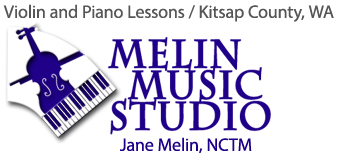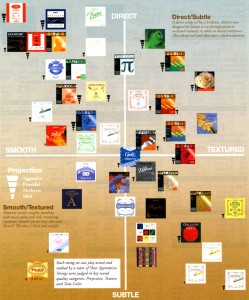How To Choose New Violin Strings
It’s a fact of life: violin strings wear out or break, and must be periodically replaced. Often student instruments are fitted out with the most inexpensive strings, which have a thin, piercing tone that only further degrades the student-violin’s limited tonal range. When students ask for recommendations on replacement strings I usually try to steer them a grade or two up from the cheapest strings so they’ll have a better-sounding instrument.
Finally someone has taken the guesswork out of deciding what type of strings to buy! Past Shar Music catalogs featured a grid-graphic that places different brands of strings along two axes: Smooth/Textured and Subtle/Direct, forming 4 quadrants. I like strings with synthetic cores that provide a warm, rich sound. They are near the center, mostly in the Textured/Direct quadrant. I cringe at the sound of the bargain-priced “Red Label” strings which are off in the upper left corner. Good value and sound for student instruments can be found in the Pirastro Tonica strings; they are in the white-and-red package near the center vertical line, on the Direct/Textured side.
HERE’S MY SECRET INGREDIENT FOR CHEAP VIOLINS: String a sub-$500 violin that has a bright/nasal/tinny/narrow tone with PIRASTRO OBLIGATO A, D and G strings for an instant upgrade! They are in the lower-right quadrant of the graph below. With an investment of about $70, your instrument will sound at least $200 more expensive!
Here is the quadrant graphic so you can search for your own preferences (click to enlarge; I also have a hard copy at the studio and can help you identify the different brands):
Since this chart was first published, Shar has revised their chart (live version here) by changing the axis directions and qualities. It’s a little confusing, but by combining the two you’ll get a pretty good idea of how different strings compare. The new chart also includes a few more brands.
If you don’t know what kind of strings you currently have, the colors of the winding thread on each end are unique to each brand and string. There are several charts online to match colors to brands. I usually start with the chart at Lashof Violins.
Violin String Review also has color-matching charts, plus user reviews of all the most popular string brands.


